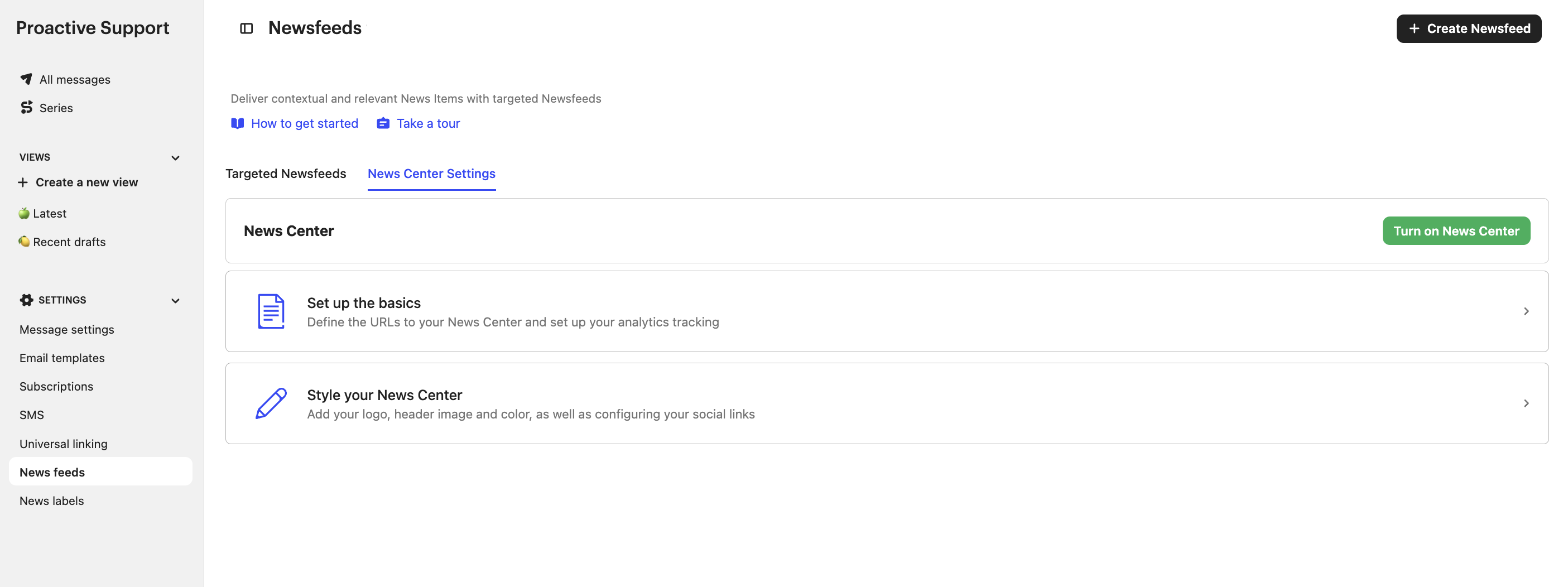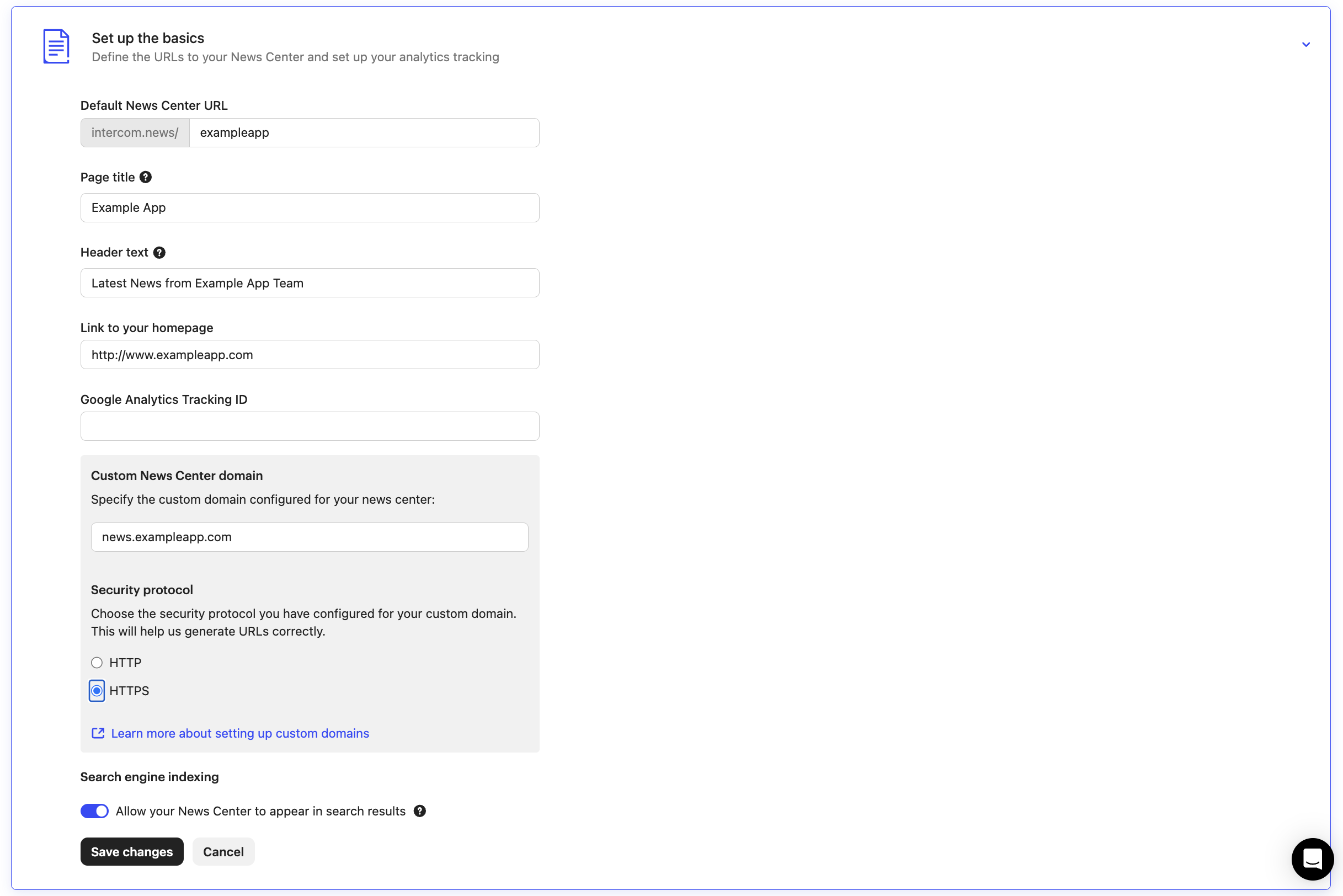When you turn on your News Center, your content is available through intercom.news by default. Your URL will look like this: intercom.news/exampleapp
To use a different URL for your News Center you will need to set up a custom domain.
Set up your custom domain in 3 steps:
1. Enter your custom domain
2. Create a custom CNAME record
3. Configure SSL (Optional)
In order for Intercom to recognize and identify logged-in users within your News Center, your website and your News Center must share a top level domain.
For example, if your domain is app.example.com, your custom News Center domain must be something like news.example.com.
Enter the custom domain you want to use in your News Center settings at Settings > Proactive Support > Newsfeeds.
First turn on your News Center.

Then add the domain, making sure that it shares the top level domain with your site where Intercom is installed.

- Go to your DNS provider’s website (e.g. GoDaddy or Cloudflare). If you’re choosing one for the first time, go with one that supports SSL.
- Create a CNAME (‘canonical name’) record for your custom domain.
- Point it at Intercom’s host domain intercom.news
News Center custom domains aren't supported for Australia or Europe regions.
These steps will vary, so check with your own DNS provider for support.
As an example, here’s how to set up a CNAME record with Cloudflare:
- Set up Cloudflare as the resolver for your custom CNAME by changing your domain nameserver to Cloudflare.
- Go to the ‘DNS’ section in Cloudflare and add a CNAME record for your News Center custom domain. Give the CNAME a Name based on the first part of your custom domain e.g. if your custom domain is news-center.example.com, use news-center.
- Point it at the Intercom host domain: intercom.news
To enable the CNAME record, toggle on Proxy Status so that cloud icon is orange.
After you set up a custom domain, your News Center will be hosted on your domain, but on HTTP rather than HTTPS. Your News Center will now appear as ‘not secure’ on web browsers like Chrome Here’s how to secure it.
SSL (or TLS), is the most widely used way to secure the connection between your server and your browser. It ensures the connection between the server and browser is encrypted and safe, and appears as HTTPS.
Here’s what an SSL-configured website (with HTTPS) typically looks like on the Chrome browser:

This is what it looks like if you’ve visited a website not secured by SSL (without HTTPS):

There are two ways to set up SSL with the News Center on your custom domain:
- Use a flexible SSL (using a third-party DNS provider like CloudFlare or AWS CloudFront)
- Use your own SSL certificate (using a TLS Termination Proxy)
You can configure SSL for your custom domain to keep sensitive information encrypted. If you want to do this, make sure you’ve set up your CNAME with a DNS provider that supports SSL, like Cloudflare.
DNS changes can sometimes take up to 72 hours to take effect, but are typically much faster.
Go to the SSL/TLS section and change SSL to ‘Flexible’ or ‘Full’.

Don’t choose ‘Full (Strict)’ as this will result in an invalid SSL certificate.
Go to ‘Page Rules’ and create a new page rule with the following settings, replacing news.exampleapp.com with your own custom domain.
Go to ‘Speed’ and disable Rocket Loader and Mirage for your custom News Center domain.
Both of these features result in Cloudflare attempting to add some javascript to your News Center. This will break functionality on your News Center due to security settings your News Center has enabled.
Your custom domain should be fully secured and ready to go. Visitors to your News Center will see the green lock icon in their browser to let them know the site is secure.
- Sign in to the AWS Management Console and open the CloudFront console.
- Choose Create Distribution
- Update the 'Origin' settings. The origin domain will be
intercom.newsand the protocol should beHTTPS only. Our servers support TLSv1.2. - Update the 'Default cache behavior' settings.
Your Cloudfront distribution must be set up to forward all headers, cookies and query strings or else some News Center features may not work.
When setting up your Cloudfront distribution, you need to select "Use legacy cache settings", which will now show the options for:
- Headers
- Query strings
- Cookies
These should be set to All
- Under 'Settings', add your custom domain, e.g.
news.exampleapp.comas an Alternate domain name and upload your SSL certificate if you have one. You need a certificate that matches your domain. If you use a certificate that does not match your domain, then you will see the following error when navigating to the HTTPS version of your website: NET::ERR_CERT_COMMON_NAME_INVALID
- Copy your distribution domain name
- Navigate to your domain provider and create a new CNAME record
- For host/name input your subdomain (ex news)
- For value input your CloudFront distribution domain name
The SSL certificate used by your News Center is a shared certificate signed by your DNS provider. It uses SNI (Server Name Indication) to secure your site.
If you wish to host your own security certificates, you can do so through a TLS termination proxy. You’ll need to edit the configuration file on your proxy webserver.
Note: If you created a CNAME record that points to intercom.news, you'll need to delete this to host your own SSL certificate.
Here are the basic instructions to set up your own SSL using Apache and Nginx webservers:
# Prerequisites: mod_ssl, mod_proxy and mod_proxy_http should be enabled
# Step 1: Acquire an SSL certificate and private key (e.g. LetsEncrypt.org)
# Step 2: Set up Apache proxy settings, example below.
# Step 3: Set custom domain in Intercom News Center settings
# Step 4: Make sure your custom domain's DNS record resolves to your Apache server
<IfModule mod_ssl.c>
<VirtualHost *:443>
ServerName your-news-site.custom-domain.com # specify your custom domain here
# Set SSL options for your own domain
SSLEngine on
SSLCertificateFile /path/to/your/fullchain.pem
SSLCertificateKeyFile /path/to/your/privatekey.pem
# Proxy SSL options
SSLProxyEngine on
SSLProxyVerifyDepth 10
SSLProxyCheckPeerCN off
SSLProxyCheckPeerName on
# Set up the reverse proxy to Intercom
ProxyPreserveHost On
ProxyPass / https://intercom.news/
ProxyPassReverse / https://intercom.news/
</VirtualHost>
</IfModule># Prerequisites: ngx_http_ssl_module and ngx_http_proxy_module should be enabled
# Step 1: set up normal server with HTTPS https://letsencrypt.org/
# Step 2: set up proxy settings as shown below
# Step 3: set custom domain in Intercom News Center settings
# Step 4: make sure your DNS record is configured to IP of your Nginx server
resolver 8.8.8.8; # use own DNS server if you have one
server {
listen 443 ssl;
server_name your-news-site.custom-domain.com; # replace this with your domain
ssl_certificate /path/to/your/fullchain.pem;
ssl_certificate_key /path/to/your/privatekey.pem;
location / {
# using "set" is important as IP addresses of Intercom servers
# changes dynamically. "set" enables nginx to follow dynamic IPs
set $intercom "https://intercom.news:443";
proxy_set_header Host $host;
proxy_pass $intercom;
}
}There are many ways to set up your own SSL certificate - we can’t guarantee that we can support every type of proxy setup. If you have specific needs, we can't support you in configuring it.
Note that you may also need to add redirect from HTTP protocol (port 80) to HTTPS as part of your server configuration.
While most modern browsers support SNI, a few older ones don’t. If you’re supporting those browsers, you should use your own SSL certificate instead. Check with your DNS provider to see if this option is available.